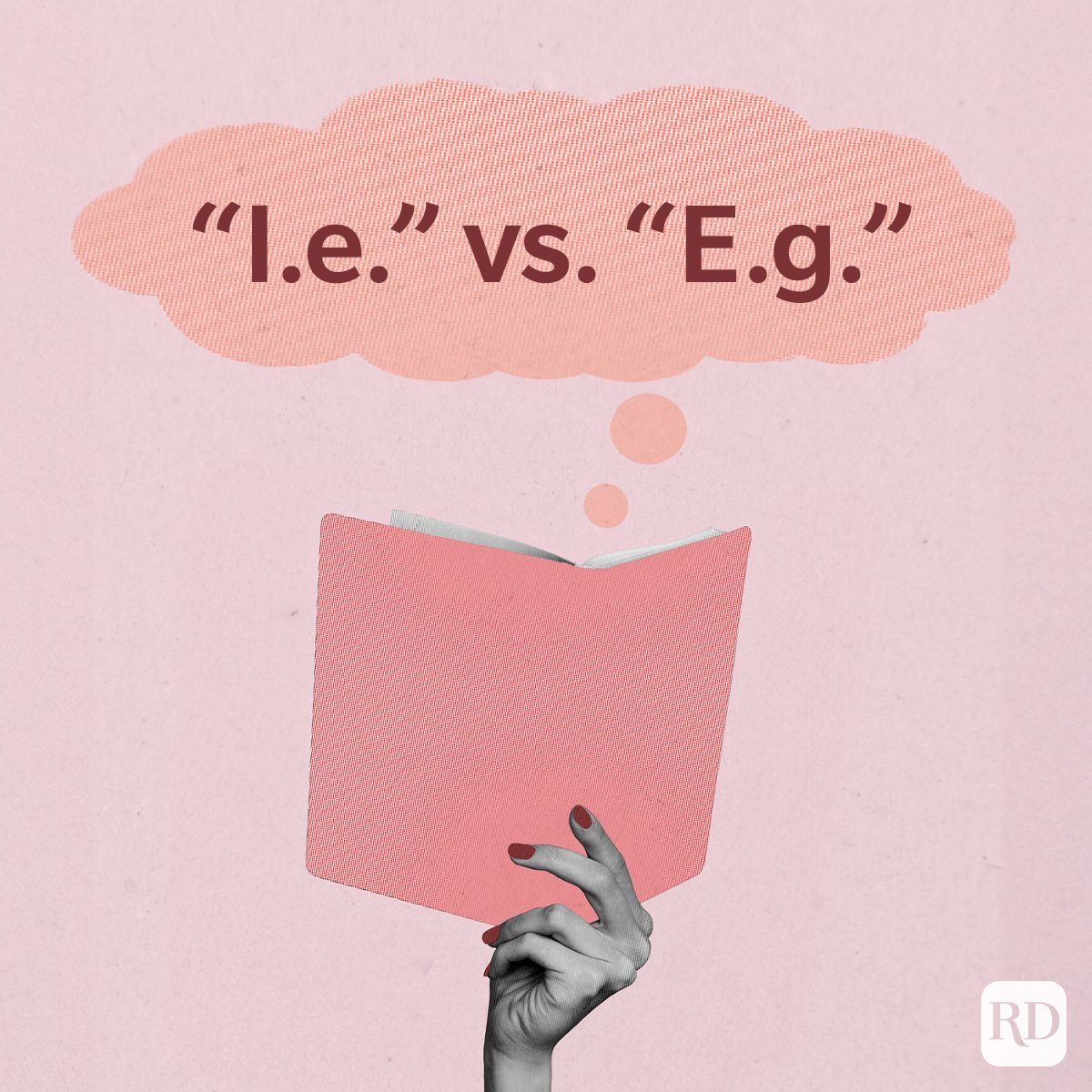These expert tips will show you exactly when to use i.e. vs. e.g. so you never make this common grammar mistake again!

Here’s When to Use “I.e.” vs. “E.g.”

Have you ever typed an email and then questioned whether you were misusing a word or abbreviation? As a longtime copy editor who earns a living correcting other people’s grammatical errors, I pay special attention to these things. But even I get tripped up occasionally by particularly tricky pairs. Should it be affect or effect? Lie or lay? And should I be using e.g. or i.e. here?
For an education on when to use i.e. vs. e.g., I turned to two linguistics experts: Michael Adams, PhD, a professor of English and linguistics at Indiana University, and Grant Barrett, a linguist, lexicographer and co-host of A Way with Words, a national radio show about language. Read on for their wise words on these abbreviations—and you’ll never be confused again.
Get Reader’s Digest’s Read Up newsletter for more grammar, humor, cleaning, travel, tech and fun facts all week long.
What’s the difference between i.e. and e.g.?
“Superficially, the distinction is easy,” says Adams. “I.e. abbreviates id est, Latin for ‘that is.’ E.g. abbreviates exempli gratia, which means ‘for example.’ Thus, i.e. introduces an explanation, and e.g. introduces examples.”
Think of e.g. like selecting pizza toppings—there is no limit to what you can add (provided that extra pepperoni, mushrooms or olives is in your budget). Think of i.e. like ordering a specific pizza from the menu—say, the Meat Lovers. You get exactly what’s listed on the menu, with no changes or substitutions.
Why do people get them confused?

“We used to learn Latin in school. Now we learn Spanish or French because they’re more useful,” says Barrett. “But when we learned Latin, these abbreviations made a lot of sense because you just knew that id est means that is and exempli gratia means for example. You just understood it.” But that’s not the case today.
“And here’s the thing,” Barrett adds. “You don’t have to use the abbreviations.” You can just spell out for example or that is. “If you don’t know what you’re doing with them, don’t use them,” he says. “This is generally a life lesson for everything: If you’re in somebody else’s tool shop, don’t pick up the power tools unless you know what you’re doing. If you’re reaching for language that you don’t quite understand, then you’re reaching too hard, and you run the chance of misusing it. And that’s where you get in trouble.”
Is there an easy way to remember the difference between i.e. and e.g.?
If you can’t commit the Latin phrases to memory, there are a couple of mnemonic devices you can try. Barrett explains: “E.g. is easy because we’ve got that E in there—like the e in example. And eg [pronounced like egg] kind of sounds like example, even though there’s no g in example.”
As for i.e., you can remember it as in essence or in other words.
Can i.e. and e.g. be used interchangeably?
No, i.e. and e.g. should not be used interchangeably, as they serve distinct functions: I.e. clarifies or restates something, while e.g. provides illustrative examples.
One way to conceptualize the difference is through punctuation: “I think of i.e. as a semicolon abbreviation,” says Adams. “I make a statement, then I make another statement that explains or adds precision to the first statement.
“I think of e.g. as a colon abbreviation,” he continues. “I make a statement on the left side of the [invisible] colon that requires illustration by example, and then I list the examples on the right side.”
How do you use i.e. and e.g. in a sentence?
“If you can just remember what the Latin phrases stand for, then you’re more likely to use them correctly because they will literally substitute right in the English,” says Barrett. “Any place that you want to put i.e. should be replaceable by that is. And any place that you want to put e.g. should be replaceable by for example. And if they’re not, then you’re using them incorrectly.”
Also, both e.g. and i.e. should be followed by a comma, and the entire phrase (the examples or clarification) should be set off by commas or parentheses; you can also use an em-dash before them. Here are a few examples:
- “She prefers to snack on citrus fruits, i.e., oranges and lemons.” This restates her preference for citrus.
- “My doctor told me to incorporate more fruit into my diet, e.g., blueberries, apples and grapefruit.” This provides examples of the fruits she needs to start eating.
- “I’m vacationing this summer in my favorite city (i.e., Paris).” This clarifies that his favorite city is specifically Paris.
- “There are so many places on my bucket list (e.g., Paris, Lisbon and Sydney).” These are examples of cities he’d like to visit.
- “The company focuses on various emerging technologies—e.g., AI, blockchain and quantum computing.” This provides examples of technologies.
- “The company specializes in just one area—i.e., artificial intelligence.” This explains that the company deals only in AI.
What do e.g. and i.e. mean in formal writing?
Both e.g. and i.e. are important in academic, legal and professional contexts. “In the transition from Latin and French as England’s legal languages to legal English, these abbreviations survived, and legal scholars, lawyers and judges all knew what they meant and, today, know what they mean,” Adams explains.
In legal writing, e.g. is used with precision to introduce examples without implying an exhaustive list. Courts, lawyers and legal scholars rely on e.g. to indicate that the listed examples are illustrative, not definitive: “The defendant must provide identification (e.g., a passport, driver’s license or government-issued ID) before proceeding.”
Legal documents require unambiguous language, and i.e. ensures that what follows is a definitive explanation or clarification of a point: “The agreement must be signed by an authorized representative, i.e., a person with signatory authority granted by the board of directors.”
So the next time you find yourself hesitating between e.g. and i.e., just remember: One offers options; the other offers clarity. And if all else fails, take Barrett’s advice—just spell it out! After all, language is meant to communicate, not complicate.
About the experts
|
Why trust us
At Reader’s Digest, we’re committed to producing high-quality content by writers with expertise and experience in their field in consultation with relevant, qualified experts. We rely on reputable primary sources, including government and professional organizations and academic institutions as well as our writers’ personal experiences where appropriate. For this piece on when to use i.e. vs. e.g., Jo Ann Liguori tapped her decades of experience as a copy editor to ensure that all information is accurate and offers the best possible advice to readers. We verify all facts and data, back them with credible sourcing and revisit them over time to ensure they remain accurate and up to date. Read more about our team, our contributors and our editorial policies.
Sources:
- Michael Adams, professor of English and linguistics at Indiana University Bloomington and author of Slayer Slang: A Buffy the Vampire Slayer Lexicon; email interview March 13, 2025.
- Grant Barrett, linguist, lexicographer and co-host of A Way with Words; phone interview March 18, 2025
- Oxford English Dictionary: “i.e.”
- Oxford English Dictionary: “e.g.”























